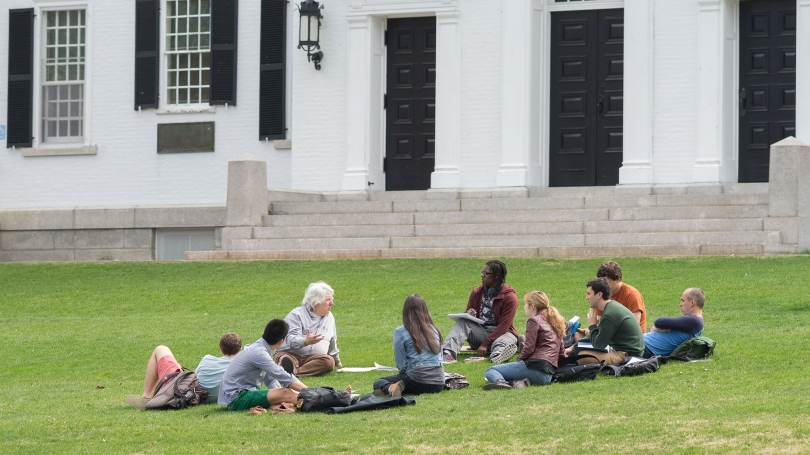
- About
- Consultation
- Programs
- Resources
- News & Events
Back to Top Nav
Back to Top Nav
Back to Top Nav
We spoke to five Dartmouth faculty members to find out how they are staying connected with their students during this time of remote learning:
Making a Space for Dialogue
Prue Merton, Lecturer in the Institute for Writing and Rhetoric, and Francine A'Ness, Associate Director at the Frank J. Guarini Institute for International Education, teach the COCO course "What's in Your Shoebox?" which asks students to reflect on their study abroad experiences. Merton and A'Ness are committed to replicating group work, discussion, and interchange in the remote learning format even while offering the course asynchronously for accessibility reasons. The class did a "Learning to Look" exercise with the Hood Museum of Art using VoiceThread, a collaborative multimedia tool where students can share responses using text, audio, and video. It allowed for an asynchronous discussion of the object while still allowing students to see each other's faces and hear their voices. The class is also using Hypothesis, a social annotation tool, which allows students to comment on the same text asynchronously. A'Ness said that students "crave being able to unpack and share stories" in real time so the students meet in pairs or small groups for Zoom discussions. Merton and A'Ness have now incorporated multiple optional class meetings on Zoom so that students in different time zones can attend if they choose to. Merton and A'Ness admit that these meetings can be time consuming, but they help meet the class goals.
Working in Groups Asynchronously
In "Authoritarianism vs. Democracy in Central & Eastern Europe," students learn about six countries and their transition to democracy. Katie Aha, Lecturer in the Government department, has divided the class into groups of six with each group member focusing on a different country. Over the course of the term, students will blog about their country, summarize what they have learned, and predict what they think will happen next. Their group will comment on their posts and ask questions, which encourages collaboration and allows students to learn about all six countries while being an "expert" on one. This allows the students, who are spread over eight time zones, to do group works while still being able to access all course material asynchronously.
Staying Connected
Over the years, Professor of Film and Media Studies Mary Flanagan's course "Film 51: Game Design Studio" has developed to be specifically analogue and centered around group work. One technology she is using to develop community is Slack, a team communication platform. She seeds Slack channels with feedback to get students to start talking to each other in the space. She also likes being on Slack because students can see when she is online and message her - similar to if they see her in the hallway after class or around campus.
Checking In
Brian Chaboyer, Professor of Physics and Astronomy, has 140 students across 19 different time zones in "Solar Systems and Exoplanets" this term so the course content is delivered asynchronously. He missed the face-to-face contact and real time feedback from class. During Week 2, he used the Mail Merge add-on in Thunderbird to send each student an email asking them how they were doing in class. Most responses were positive, but he did receive emails from students who were struggling in class and he was able to reach out to them individually about their issues.
Looking for other ways to stay connected with your students? The DCAL and LDT teams have compiled a list of 5 Ideas for Checking In with Your Students.